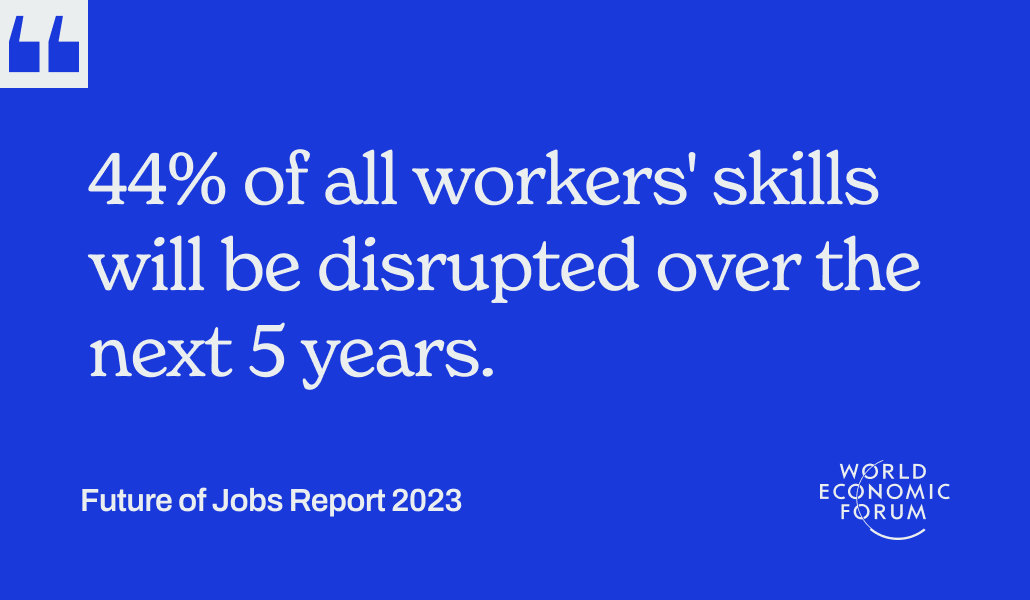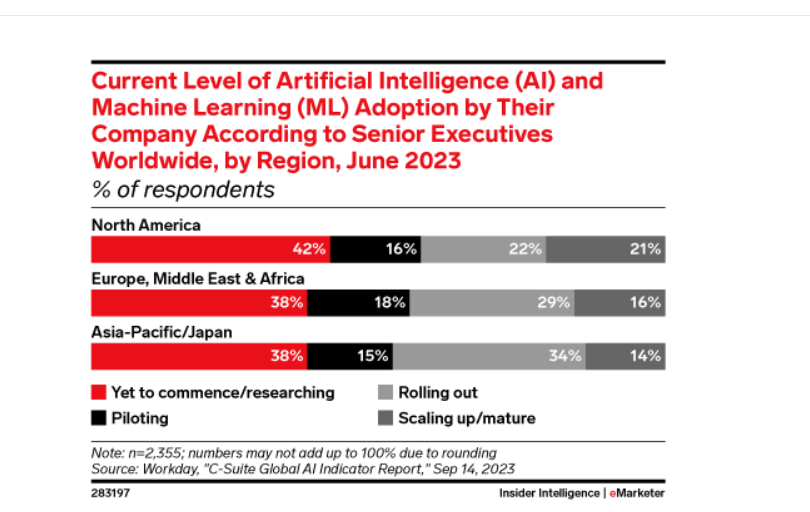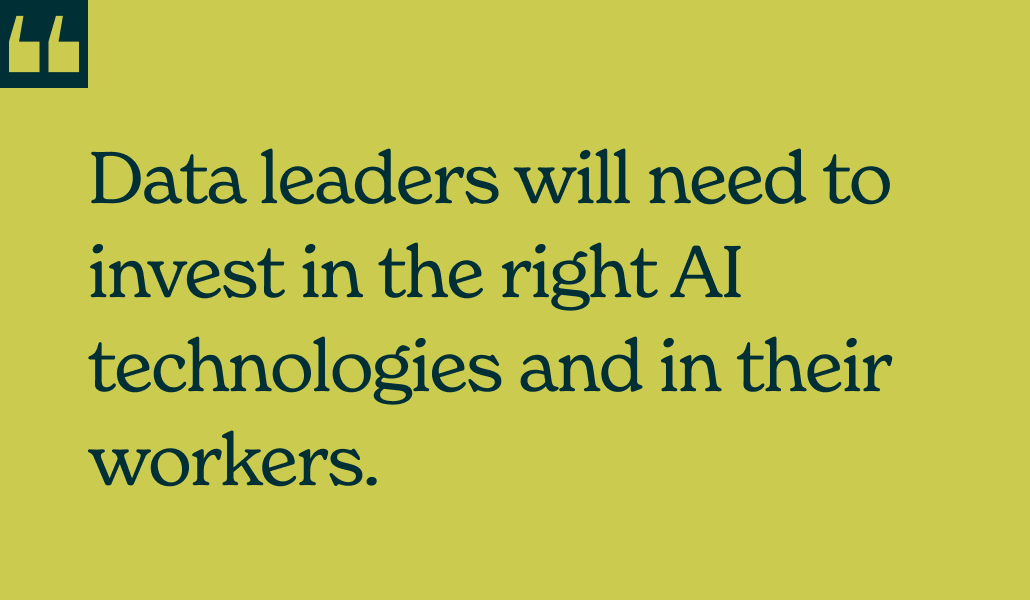In a nutshell:
- AI is revolutionizing the field of data analytics, automating tasks and freeing up time for more valuable work.
- Data analysts will still play a crucial role in ensuring the accuracy and relevance of AI-generated insights.
- AI can save costs by upskilling existing employees rather than hiring new ones.
- It’s important to prioritize data quality and familiarize yourself with the available AI tools.
- Collaboration with key stakeholders and investment in AI technologies are essential for success in the age of AI.
“English is the hottest new programming language,” said Andrej Karpathy, a leading researcher at Open AI and previously the director of AI at Tesla.
What did he mean?
With AI, writing code has become as simple as typing a few sentences into a chat interface. Not only can AI help write and edit code, but it can also automate many other data-related tasks, like cleaning data, creating reports, and even building models.
Does this new technology spell the end of the data analyst? Not even close — and we don’t believe it ever will.
While generative and other forms of AI, such as predictive AI, have the ability to automate many time-consuming aspects of data-related work, it’s unlikely to ever replace humans. Instead, it will continue to evolve as a tool that augments analysts’ productivity. In this blog, we explore the future of data analytics and take a look at how analysts and data leaders can prepare for an AI-powered, data-centric future.

How will AI change the role of data analysts?
Disruption isn’t unique to data workers. The World Economic Forum’s Future of Jobs Report 2023 estimated that 44% of all workers’ skills will be disrupted over the next five years. While the fact that nearly half of all workers’ skills will change is startling, the contrasting skills that will rise in importance shouldn’t come as a surprise: creativity, technology literacy, and cognitive skills — like problem-solving and strategic thinking.
While AI can automate repetitive and time-consuming tasks, it can’t replace humans. It simply lacks the emotional intelligence, creativity, expertise, and strategic knowledge that only humans possess.
However, there is a lot of potential to AI and automation. Just consider these results from Microsoft’s 2023 Work Trend Index Report: 64% of employees today don’t have enough time and energy to get their work done. In light of that, as many as 70% of employees say they would delegate as much work as possible to AI to lessen their workloads. The result? More time for value-added, uniquely human activities.
The role of the data analyst isn’t disappearing. Far from it — it’s getting a facelift. Instead of spending hours in data prep, report building, coding, etc., analysts can take on new, more exciting tasks related to collaboration, interpretation, and communication with business stakeholders.
Moreover, they’ll be the experts, ensuring that AI is fueled by the right data and finding the right answers. After all, any organization that unquestioningly accepts the outputs from AI is not doing its due diligence. Analysts will become the stewards of high-fidelity data, the fuel that powers AI. And once insights are ready, analysts will be the experts who translate those insights to strategic decisions.
While the advent of generative AI will change the analyst’s role, it’s a chance for data workers to level up in their careers while performing more fun and exciting analytics and automating the drudgery that too often comes with routine data tasks.
How will AI change the role of analytics leaders?
If you’re an analytics leader in your organization, you may wonder how AI will impact your team and organization. With less headcount and less budget, many business leaders have struggled to do more with less throughout 2023. AI is the solution.
Simply put: AI has a multiplicative effect on teams and individuals. These tools can automate and accelerate work to save hours of labor while enabling data workers to find deeper insights faster.
And while there is an up-front technology cost associated with AI, there’s also a major cost-savings element, both in the labor hours and the potential for upskilling. Data scientists have become rarer and more expensive than ever, but with the right tools, analysts can perform many of the same tasks — and faster.
Just consider this example of hiring costs for software engineers versus the cost to upskill internal employees. Research suggests that “the cost of recruiting a mid-career software engineer (who earns $150,000-$200,000 per year) can be $30,000 or more … This new hire also requires onboarding and has a potential turnover of two to three times higher than an internal recruit. By contrast, the cost to train and reskill an internal employee may be $20,000 or less, saving as much as $116,000 per person over three years.”
Upskilling data analysts through the power of AutoML and other AI solutions can give your data team the critical skills it needs while saving massive hiring costs. Then, there is the direct benefit to your organization. Many data analytics teams like yours have huge request queues for new reports, dashboards, analytics, and so on. Often, teams can only service the most critical initiatives. AI can help automate and accelerate many steps of the data analytics process to help you and your team provide more business stakeholders with the vital insights they need.
With 40% of organizations worldwide yet to adopt any kind of AI solutions, the opportunity for business leaders to get ahead of the game is unmistakable — but it will require initiative.

How to begin your AI journey
Ready to delve into the world of AI? Here are a few steps you can take to set yourself up for success.
Ensure data quality
First and foremost, whether you’re an analyst or a business leader, you’ll have to ensure your data is of the highest quality. As the chief data officer at Salesforce explains, “As companies rapidly embrace AI and realize its benefits, trust must be their top priority. And to instill trust in AI, they must first instill trust in the data that powers it. … Simply put, organizations can only harness the full power of AI when it is fueled by accurate, comprehensive data.” Making sure you and your team have the skills and technology necessary to effectively clean and prepare your data is your first priority.
87% of IT and analytics leaders say advancements in AI make data management a top priority.
— “State of Data and Analytics,” Salesforce
Familiarize yourself with the tools available
Whether it’s AutoML, predictive AI, or even Predictive GenAI, you’ll have to familiarize yourself with the different AI tools available. If you’re an analyst, you’ll need to learn how to use these. If you’re an analytics leader, you’ll have to decide which of these tools are nice-to-haves and which are must-haves.
Even within the different types of AI, solutions are becoming increasingly specialized and use-case specific. For example, Pecan’s AutoML platform can quickly help marketers and salespeople optimize marketing ROI, predict high lifetime value customers, and reduce churn, while other platforms may be able to help you quickly write code or summarize reports.
In addition, you’ll have to consider what level of customization you’ll need. A fully automated AI platform will work differently than a low-code platform that offers customization options, whether for feature engineering, nuanced use cases, or something else.
Align with key stakeholders
Finally, consider partnering with key stakeholders such as the CIO and CHRO to discuss your budget for AI technology. This conversation should include time savings, labor costs, plans to upskill employees, and how to best roll out an effective AI strategy for your team in 2024.
Tap into the full value of your data
While AI will undoubtedly change how analysts and organizations operate, it presents a unique opportunity to find deeper insights and perform more meaningful work. But to take advantage of this opportunity, analysts will need to build new skills, ensuring they understand the nuances of AI.

Similarly, data leaders will need to invest in the right AI technologies and in their workers, ensuring they possess the skills required for the age of AI. Doing so will reap rewards that last for years to come.
Ready to unlock your data’s potential and guide your organization forward into the future of data analytics? Start your AI journey with a free trial of Pecan’s predictive AI platform.



